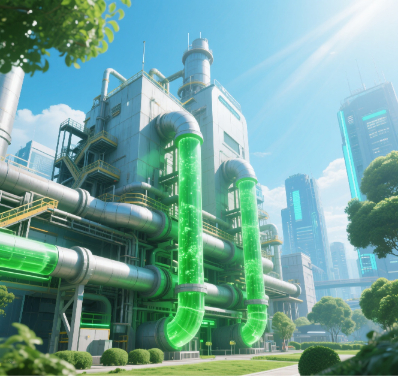In the global pursuit of carbon neutrality, green ammonia (NH₃) has emerged as a pivotal solution, effectively bridging the gap between surplus renewable energy and the urgent need for deep decarbonization in various sectors. Unlike conventional “gray ammonia,” which is produced from fossil fuels using the Haber–Bosch process, green ammonia is synthesized using hydrogen from renewable-powered electrolysis and nitrogen from the air. This innovative production method results in nearly zero carbon emissions throughout its lifecycle, making green ammonia a cornerstone of the transition to a sustainable future.
Diverse Applications Driving Green Ammonia Adoption
Green ammonia’s versatility is underscored by its diverse applications, which significantly influence key sectors.
- Agriculture and Industrial Feedstock: Green ammonia can replace grey ammonia in the production of fertilizers and industrial chemicals. With global ammonia demand at around 180 million tons per year, 75% of which is used for fertilizers, shifting towards green ammonia is essential. For example, Yara’s pilot project in Brazil reduced urea emissions from 1.8 tons to 0.2 tons of CO₂ per ton, demonstrating the potential for significant environmental impact. BASF’s ambitious plan to replace all European ammonia feedstock with green ammonia by 2030 further emphasizes the industry’s dedication to decarbonization.
- Hydrogen Carrier: Green ammonia offers a practical solution to the challenges associated with hydrogen transport. Ammonia has a higher energy density and is easier to liquefy than hydrogen, making it a cost-effective option for long-distance transportation. The Japan-Australia supply chain is a prime example of this. Solar-powered green ammonia is shipped to Japan, where it is converted into hydrogen. This process achieves a 40% cost reduction compared to liquid hydrogen.
- Zero-Carbon Shipping Fuel: Green ammonia is a promising alternative that addresses the maritime industry’s significant carbon footprint. Shipping comprises 3% of global CO₂ emissions and is a challenging sector to decarbonize. Ammonia’s advantages, such as its higher energy density and compatibility with existing engine technologies, make it a viable option. Notable projects, such as the Yara Birkeland—the world’s first ammonia-fueled container ship, scheduled to launch in 2026—and the International Energy Agency’s (IEA) forecast that ammonia will meet 45% of the shipping fuel demand by 2050, highlight its potential in this sector.
- Power Sector: Green ammonia plays a crucial role in energy storage and low-carbon power generation. It can be used for seasonal storage by converting excess renewable energy into ammonia, which can then be converted back into electricity during peak demand periods. Additionally, co-firing ammonia in power plants reduces carbon emissions. Japan’s JERA has achieved a 20% ammonia-coal co-firing rate, which has resulted in a significant annual reduction in CO₂ emissions.
Regional Development Strategies
The global race to dominate the green ammonia market is characterized by diverse regional strategies.
- China: China’s robust policies aim to support 10% ammonia co-firing in coal plants by 2027. With 84 green ammonia projects planned, totaling 1.43 billion tons per year in capacity, China is positioning itself as a major producer. Notable milestones include developing the first ammonia-fueled ship for inland waterways and testing ammonia (NH₃) as an alternative to coke in steelmaking.
- Japan: Japan is focusing on technological leadership and supply chain control. The country holds 60% of core patents in ammonia combustion. The country’s roadmap envisions 20% ammonia power by 2030 and 100% by 2050. This will be achieved by leveraging its patent dominance and reducing its reliance on imports from projects like Australia’s North Queensland.
- Australia: Leveraging its cost advantage in renewable energy, the North Queensland project in Australia produces electricity at $0.15/kWh, which is 40% cheaper than in Europe. With a focus on exports, dedicated ammonia carriers will supply Japan and South Korea, establishing Australia as a leading exporter.
- Europe: Pioneering maritime and regulatory advancements, Europe is developing a robust ammonia bunkering network in Norway. The EU’s Carbon Border Adjustment Mechanism (CBAM) will impose carbon tariffs on gray ammonia imports by 2030, which will foster the adoption of green ammonia.
- S.: The U.S. is advancing with projects like CF Industries’ nuclear-powered NH₃ plant, combining infrastructure development with nuclear synergy. DOE-funded R&D aims to reduce ammonia cracking costs and enhance competitiveness.
- Middle East: Saudi Arabia’s NEOM project aims to utilize its abundant solar resources to produce 120,000 tons of green ammonia per year, positioning the Middle East as a significant export hub.
Future Competition and Key Challenges
The future of green ammonia depends on three main areas of competition:
- Cost reduction: A target price of $150 per ton is essential, down from the current price of $400. Innovations such as plasma synthesis and bio-nitrogen fixation are critical pathways.
- Standardization: Establishing international safety and carbon accounting standards, such as the International Maritime Organization (IMO) rules for ammonia (NH₃) ships and European Union (EU) methods, will ensure market integrity and safety.
- Regional Alliances: Forming trade blocs such as the Asia-Pacific (Australia, Japan, Korea, and China) and the Atlantic (the U.S., Europe, and Africa) will influence market dynamics and competitive landscapes.
A Transformative Force in the Global Energy Landscape
Green ammonia is poised to transform global energy and chemical supply chains. It will turn fertilizers into climate solutions, make shipping a pioneer of zero-carbon technology, and turn renewables into tradable global commodities. With China’s size, Japan’s technological expertise, and Australia’s cost-efficiency leading the way, the competition for green ammonia dominance is about more than just economic gains; it’s also about establishing the rules of the post-fossil era. By 2030, green ammonia is projected to be a $100 billion industry, with Europe and Norway excelling in maritime applications. The transition has begun, and the pioneers of green ammonia are paving the path to a sustainable future.









